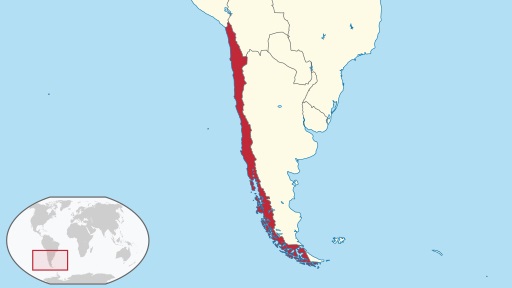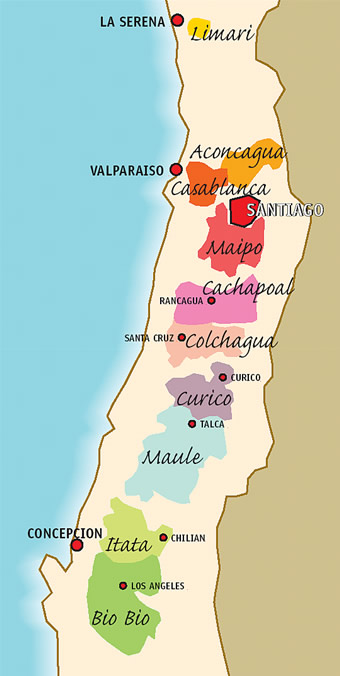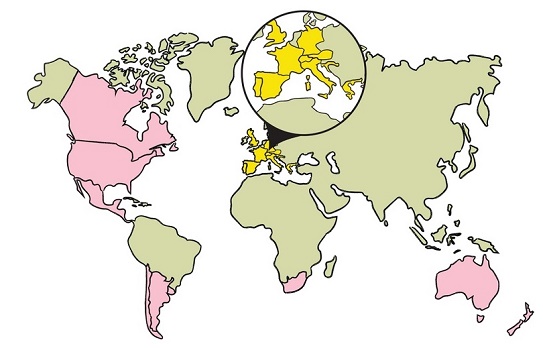Chilean Wine
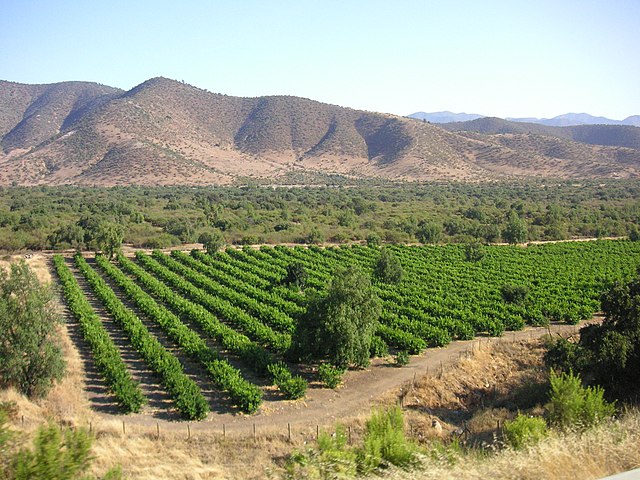
Chilean vineyard in the foothills of the Andes
Chilean Varieties 2023
CABERNET SAUVIGNONSauvignon Blanc País Merlot Carménère Chardonnay Syrah Moscatel De Alejandría Pinot Noir Pedro Gimenez Cabernet Franc
| Grape | Description |
|---|---|
| Chardonnay | From the calcareous soils of the Limarí valley. Fruit notes and good body. |
| Sauvignon Blanc | The valley of Casablanca or San Antonio. Refreshing acidity and light body. |
| Carmenère | From the valley of Cachapoal or Colchagna. Spicy notes and soft tannins. |
| Cabernet Sauvignon | From the valley of Maipo. Described as the "Bordeaux of South America". Robust structure and intense notes of black fruit. |
| Pinot Noir | From the calcareous soils of the Limarí valley. |
Atacama Region
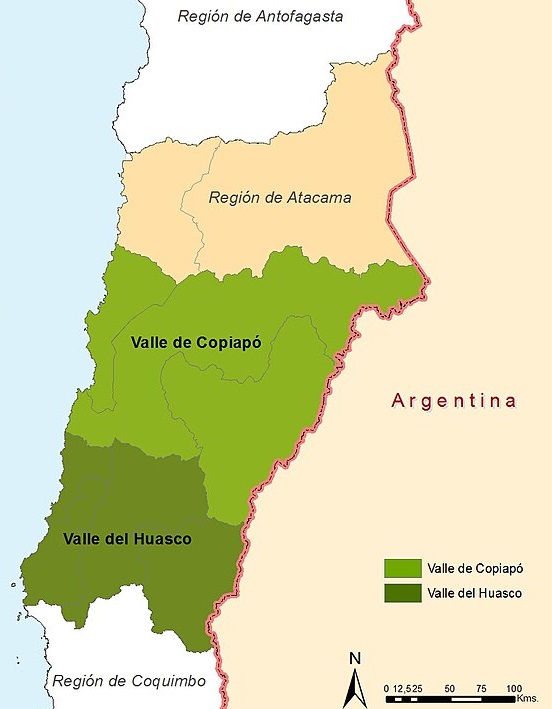
| GRAPES | HECTARES |
| Chardonnay | 10 |
| Sauvignon Blanc | 10 |
| Syrah | 6 |
| Pinot Noir | 6 |
| Pais | 4 |
| Malbec | 3 |
| Merlot | 3 |
| Garnacha | 3 |
| Moscatel De Alejandría | 3 |
| Alicante Bouschet | 1 |
| Carmenère | 1 |
| Cabernet Sauvignon | 1 |
Copiapó
Atacama is home to the world’s driest non-polar desert, Copiapó.
In the desert, winemaking is irrigated with water from natural oases. Most of the vineyards produces Pisco (distilled spirit) and table grapes.
A number of different Muscat grapes are used to make Pisco, including Muscat of Alexandria.
Muscat grapes are also used to make drier table wines.
Huasco Costa
In Huasco Costa, Sauvignon Blanc, Chardonnay and Syrah wines grow under the cool coastal influence of morning fog and strong breezes from the Pacific coast. These factors, and calcareous soils, produce elegant and complex wines with natural acidity and saline notes.
Huasco Alto
In the Huasco Alto inland, fresh, sweet and aromatic wines are produced under the name of Pajarete, a blend of different Muscat grapes (Yellow Muscat, White Early Muscat, Muscat of Alexandria, Austrian Muscat, Frontignan Muscat, Hamburg Muscat, Pink Muscat, Orange Muscat) grown at more than 1,100 meters above sea level.
Coquimbo
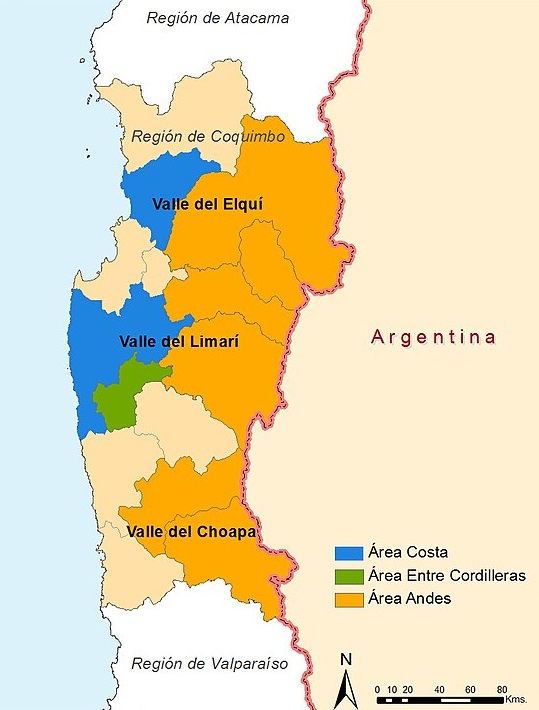
| GRAPES | HECTARES |
| Chardonnay | 800 |
| Syrah | 400 |
| Pedro Jiménez | 400 |
| Alicante Bouschet | 250 |
| Sauvignon Blanc | 250 |
| Pinot Noir | 175 |
| Pinot Gris | 150 |
| Moscatel De Alejandría | 100 |
| Cabernet Sauvignon | 100 |
Valle del Elqui
The Elqui Valley is an arid area with some of the most important astronomical observatories in the world. The vineyards are growing on green dots on the mountainsides where rustic soils is the right environment for Syrah and Sauvignon Blanc grapes.
The altitude is moderating the climate. The grapes receive intense sunlight during the day. A large diurnal temperature variation allows the grapes to retain a high level of acidity while ripening fully.
Dry Pedro Jiménez from high elevation vineyards at 2,000 meters (6,500 ft) is a stylish white wine with appealing floral aromas.
Valle del Limarí
The Limarí Valley is recognized for the presence of calcareous soils and a potential for producing Chardonnay. The Syrah is recognized worldwide, and the region is also beginning to produce an exceptional Pinot Noir.
Valle del Choapa
The Choapa Valley, located in the mountains, also produces a very interesting Syrah.
Soil | Climate |
|
Hilly |
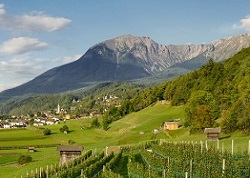
Brilliant Sunshine |
Aconcauga Region
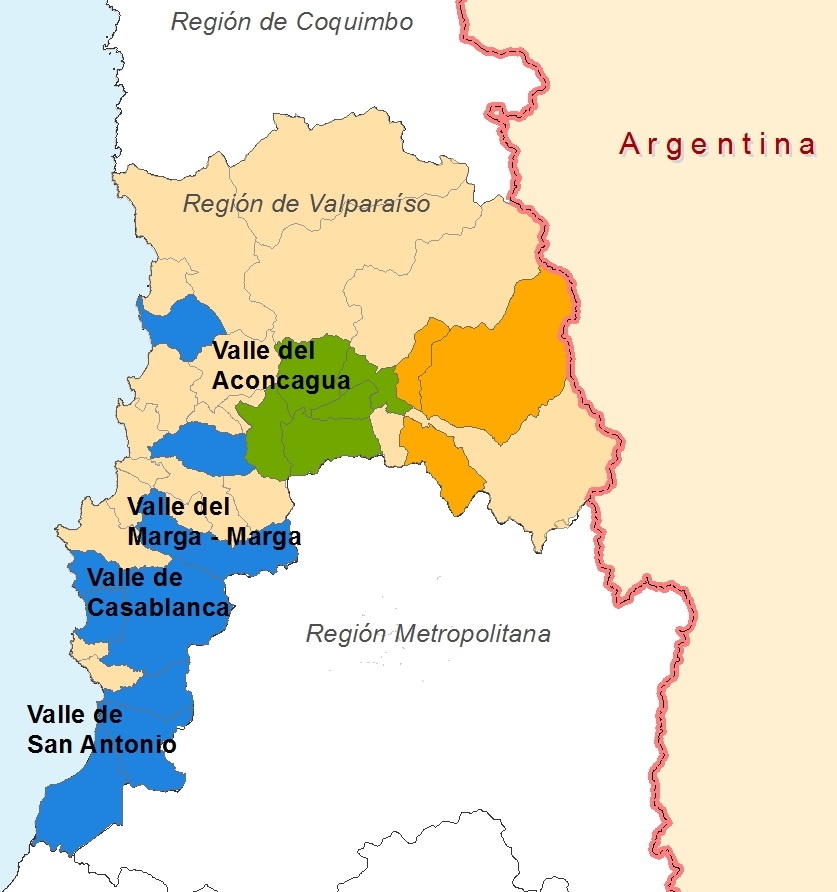
Valle de Casablanca
Casablanca Valley has become one of Chile's quality wine regions. It has a growing season up to a month longer than the other regions.
Casablanca is best known for crispy white Sauvignon Blanc and Chardonnay, but also for cool climate Pinot Noir in the coastal area.
The Pacific cools its climate, the morning fog settles in the valley, and the granitic clay soils create rich terroirs.
| GRAPES | HECTARES |
| Sauvignon Blanc | 2,250 |
| Chardonnay | 1,400 |
| Pinot Noir | 850 |
| Merlot | 250 |
| Syrah | 100 |
Valle del Aconcagua
Aconcagua Valley is a hot and dry valley, not the best suitable for wine production, but the valley is known for producing modern style quality wines. It was formed by the Aconcagua River, which runs from the Andes Mountains to the Pacific Ocean. On the banks there are alluvial and colluvial terraces that are ideal for growing wine grapes.
Cabernet Sauvignon, Carmenère, and Syrah have a long tradition in the inland valley near the Andes, while the cold climate varieties Chardonnay, Sauvignon Blanc and Pinot Noir are showing excellent results in the coastal zone.
| GRAPES | HECTARES |
| Cabernet Sauvignon | 400 |
| Carmenère | 225 |
| Sauvignon Blanc | 200 |
| Syrah | 200 |
| Chardonnay | 175 |
| Pinot Noir | 150 |
Valle de San Antonio
San Antonio Valley produces quality Sauvignon Blanc and Pinot Noir and internationally respected cold climate Syrah and Chardonnay.
The soil is thin and rocky, producing wines renowned for their minerality and good acidity.
| GRAPES | HECTARES |
| Sauvignon Blanc | 1,000 |
| Pinot Noir | 525 |
| Chardonnay | 250 |
| Syrah | 100 |
Soil | Climate |
|
Alluvial Terraces |

Hot and Dry |
Central Valley Region
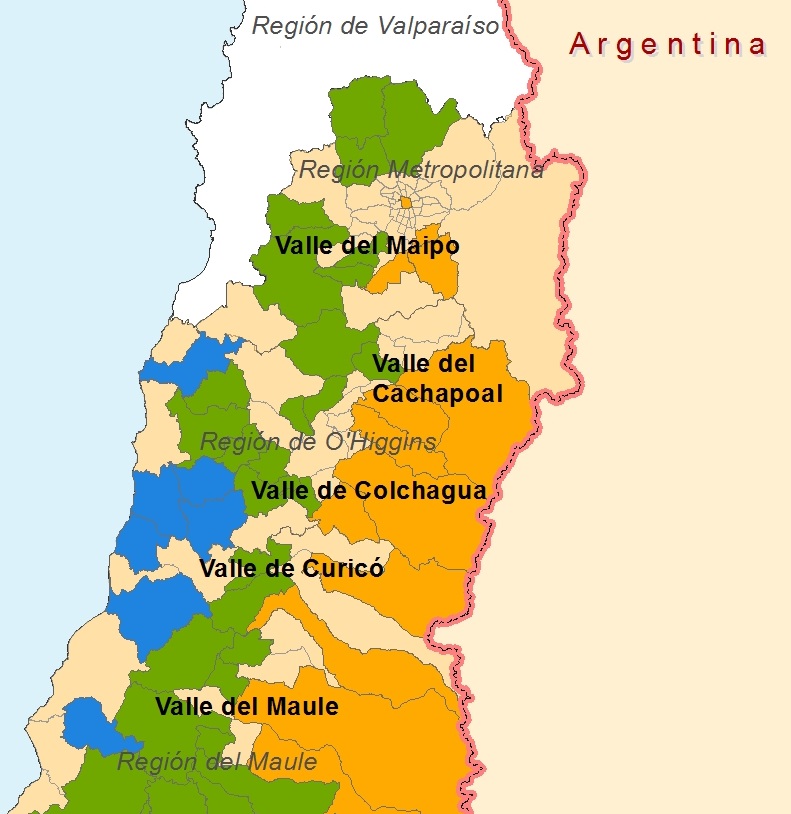
Valle del Maipo
Maipo Valley is the home to some of the best wines in Chile. It is is known for producing a rich and fruit-driven Cabernet Sauvignon described as the "Bordeaux of South America".
| GRAPES | HECTARES |
| Cabernet Sauvignon | 5,500 |
| Merlot | 900 |
| Syrah | 900 |
| Carmenère | 700 |
| Sauvignon Blanc | 600 |
| Chardonnay | 600 |
Valle de Cachapoal
Low elevation and coastal hills in Cachapoal Valley allows the Pacific breezes to interact with the Andean winds, cooling the valley and extending the ripening period, which benefits the preservation of acidity in the grapes.
| GRAPES | HECTARES |
| Cabernet Sauvignon | 4,000 |
| Carmenère | 2,000 |
| Merlot | 1,250 |
| Alicante Bouschet | 900 |
| Chardonnay | 800 |
| Syrah | 600 |
| Sauvignon Blanc | 600 |
| Malbec | 200 |
Valle de Colchagua
The Colchagua Valley has varied microclimates that create the right environment for a wide range of wines, from cool-climate varieties in the elevated vineyards in the foothills of the Andes, to warmer varieties in the areas surrounding Lake Rapel along the coastal hills.
In this valley, the gentle breezes from the Pacific Ocean and the clay soils synergize to create one of the most outstanding Carménère producing regions in the country.
| GRAPES | HECTARES |
| Cabernet Sauvignon | 12,000 |
| Carmenère | 3,650 |
| Merlot | 3,100 |
| Alicante Bouschet | 2,500 |
| Syrah | 2,150 |
| Chardonnay | 1,900 |
| Sauvignon Blanc | 1,700 |
| Malbec | 900 |
| Pinot Noir | 400 |
| Viognier | 300 |
Valle de Curicó
The Curicó Valley has an annual rainfall of 600 mm, mainly in the winter. This provides a good climate for producing healthy grapes.
Cabernet Sauvignon, Carmenère, Merlot, Sauvignon Blanc and Chardonnay are the main grapes planted in the valley:
| GRAPES | HECTARES |
| Sauvignon Blanc | 4,600 |
| Cabernet Sauvignon | 4,500 |
| Merlot | 2,100 |
| Alicante Bouschet | 1,800 |
| Chardonnay | 1,600 |
| Carmenère | 1,200 |
| Syrah | 550 |
| Malbec | 400 |
| Pinot Noir | 400 |
Valle del Maule
Maule Valley is Chile's largest wine region. It has been known for producing cheap table wine, but the production is gradually beeing replaced with better quality.
| GRAPES | HECTARES |
| Cabernet Sauvignon | 10,600 |
| Pais | 6,000 |
| Merlot | 2,900 |
| Sauvignon Blanc | 2,700 |
| Carmenère | 2,200 |
| Chardonnay | 2,100 |
| Alicante Bouschet | 1,600 |
| Syrah | 1,600 |
| Carignan | 700 |
| Malbec | 600 |
The Southern Region
Southern Region is popular for boxed and bulk wine. It is further to the south, has more rainfall, lower temperatures and fewer hours of sunlight that the northern regions.
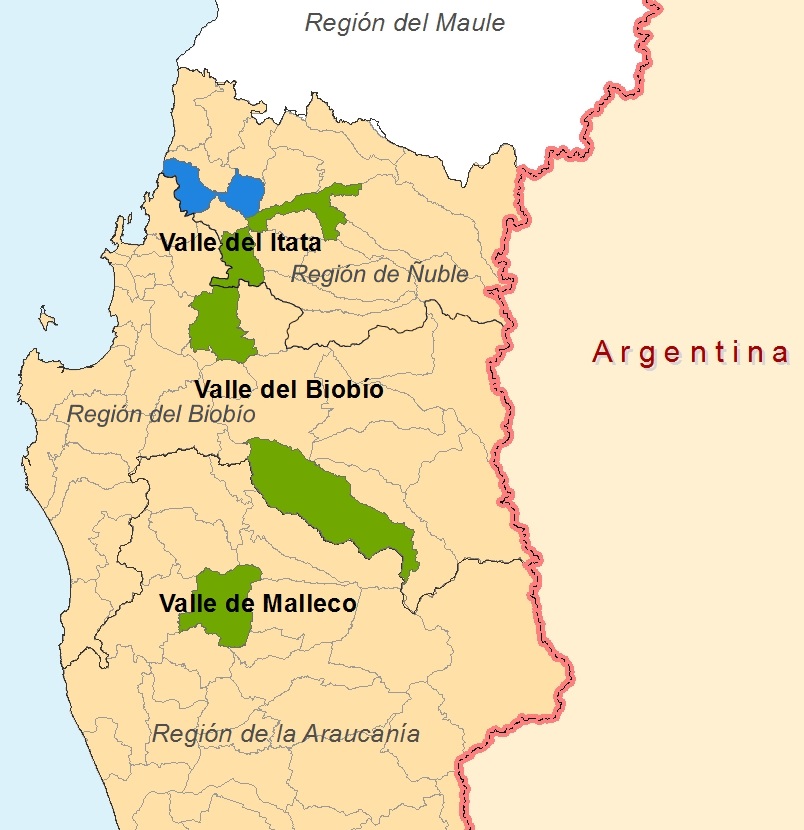
| GRAPES | HECTARES |
| Pais | 4,200 |
| Moscatel de Alejandría | 4,000 |
| Cinsault | 850 |
| Cabernet Sauvignon | 750 |
| Pinot Noir | 750 |
| Chardonnay | 450 |
| Sauvignon Blanc | 350 |
| Chasselas | 250 |
| Chardonnay | 200 |
| Merlot | 200 |
| Carmenère | 200 |
Valle del Itata
The Itata Valley, located in the Bío-Bío region, has more than 500 years of wine-making history.
It has a humid Mediterranean climate and lower temperatures than the other wine regions in Chile. Differentiated seasons and a mineral rich sandy granitic soils, gives high productivity and favours traditional grapes such as País and Moscatel de Alejandría.
Recently the region has started cultivating finer varietals like Cabernet Sauvignon, Pinot Noir, Merlot, Chardonnay and Sauvignon Blanc, with focus on organic production and high quality.
Valle del Biobío
The Bío-Bío Valley marks the transition to the south of Chile, which was considered too cold for viticulture.
With a cold and windy climate, even in summer, the rainfall reaches 1,100 mm per year. The soil is sandy and stony, and the organic fluvial deposits make it fertile and productive.
The cool climate is favorable for Burgundian varieties. Chardonnay and Pinot Noir are very promising. It can also be suitable for Sauvignon Blanc and Riesling south of the Biobío River.
Valle de Malleco
The Malleco Valley, located between the Andes and Nahuelbuta mountain ranges, is the smallest and southernmost sub-zone that extends up to 40º south.
The Malleco Valley is growing cool-climate varieties such as Chardonnay and Pinot Noir.
Chile is New World
Alcohol can be addictive. Always drink in moderation.
© Copyright 2015-2025 W3 Wine School. All Rights Reserved.
